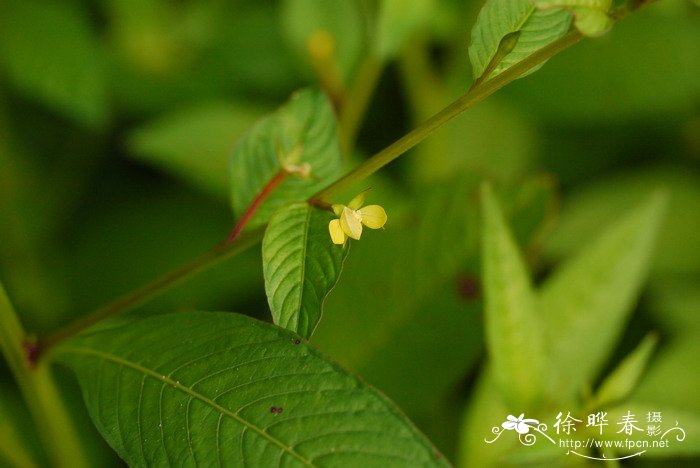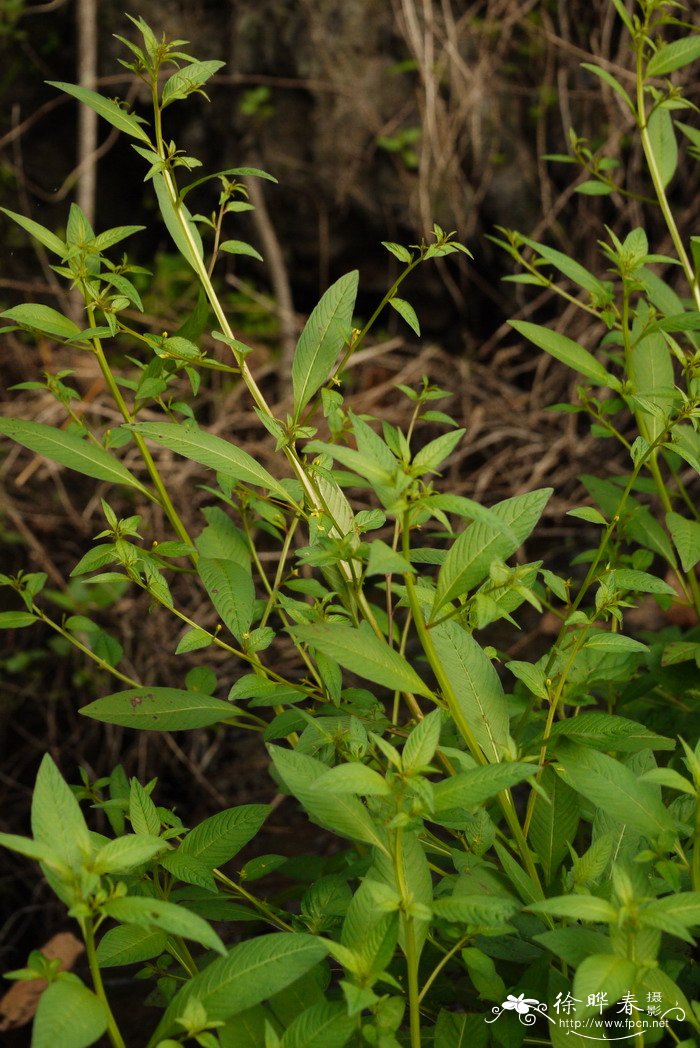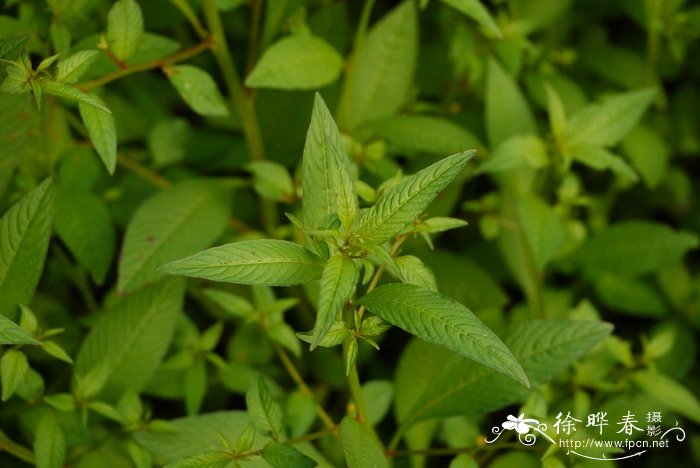假柳叶菜Ludwigia epilobioides
中文名(Chinese Name):假柳叶菜
学名(Scientific Name):Ludwigia epilobioides Maxim.
英文名(English Common Name):
别名(Chinese Common Name):
异名(Synonym):Ludwigia epilobiloides Maxim. Jussiaea fauriei H. Lév. Jussiaea greatrexii H. Hara Jussiaea japonica H. Lév. Jussiaea parmentieri H. Lév. Jussiaea philippiana H. Lév. Ludwigia epilobioides subsp. greatrexii (H. Hara) P.H. Raven Ludwigia greatrexii (H. Hara) H. Hara Nematopyxis japonica Miq.
科属(Family & Genus):柳叶菜科(Onagraceae)柳叶菜属
形态特征(Description): 一年生粗状直立草本;茎高30-150厘米,粗3-1.2厘米,四棱形,带紫红色,多分枝,无毛或被微柔毛。叶狭椭圆形至狭披针形,长(2-)3-10厘米,宽(0.5-)0.7-2厘米,先端渐尖,基部狭楔形,侧脉每侧8-13条,两面隆起,在近边缘彼此环结,但不明显,脉上疏被微柔毛;叶柄长4-13毫米;托叶很小,卵状三角形,长约1.5毫米。萼片4-5(-6),三角状卵形,长2-4.5毫米,宽0.6-2.8毫米,先端渐尖,被微柔毛;花瓣黄色,倒卵形,长2-2.5毫米,宽0.8-1.2毫米,先端圆形,基部楔形;雄蕊与萼片同数,花丝长0.5-1毫米;花药宽长圆状,长约0.5毫米,开花时以单花粉直接授在柱头上;花柱粗短,长1-0.5毫米;柱头球状,径0.6-0.8毫米,顶端微凹;花盘无毛。蒴果近无梗,长1-2.8厘米,粗1.2-2毫米,初时具4-5棱,表面瘤状隆起,熟时淡褐色,内果皮增厚变硬成木栓质,表面变平滑,使果成圆柱状,每室有1或2列稀疏嵌埋于内果皮的种子;果皮薄,熟时不规则开裂。种子狭卵球状,稍歪斜,长0.7-1.4毫米,径0.3-0.4毫米,顶端具钝突尖头,基部偏斜,淡褐色,表面具红褐色纵条纹,其间有横向的细网纹;种脊不明显。花期8-10月,果期9-11月。
分布(Distribution):产黑龙江、吉林、辽宁、内蒙古、陕西、河南、山东、安徽、浙江、江西、福建、台湾、广东、海南、广西、湖南、湖北、四川、贵州、云南。生于湖、塘、稻田、溪边等湿润处,海拔0-800米,云南在1200-1600米。日本、朝鲜半岛、俄罗斯远东地区、越南也有。
用途(Use):嫩枝叶可作饲料,全草入药,有清热利水之效,治痢疾效果显著。
引自中国植物志英文版:FOC Vol. 13 Page 401, 402
Ludwigia epilobioides Maximowicz, Mém. Acad. Imp. Sci. St.-Pétersbourg Divers Savans. 9 [Prim. Fl. Amur.]: 104. 1859.
假柳叶菜 jia liu ye cai | Onagraceae | Ludwigia
Jussiaea fauriei H. Léveillé; J. greatrexii H. Hara; J. japonica H. Léveillé; J. parmentieri H. Léveillé; J. philippiana H. Léveillé; J. prostrata var. fauriei (H. Léveillé) H. Léveillé; J. prostrata var. parmentieri (H. Léveillé) H. Léveillé; J. prostrata var. philippiana (H. Léveillé) H. Léveillé; Ludwigia epilobioides subsp. greatrexii (H. Hara) P. H. Raven; L. greatrexii (H. Hara) H. Hara; Nematopyxis japonica Miquel.
Herbs erect, often stout, annual. Stems 15-130 cm tall, well-branched, subglabrous or finely puberulous. Petiole 3-15 mm; leaf blade narrowly elliptic to narrowly lanceolate, 1-10 × 0.4-2.5 cm, subglabrous or puberulous, lateral veins 8-13 per side, submarginal vein inconspicuous, base narrowly cuneate, apex acuminate. Sepals 4 or 5, rarely 6, deltate, 1.5-4.5 mm, puberulous. Petals yellow, obovate, 1.8-2 × 0.7-1.2 mm. Stamens as many as sepals; filaments 0.5-1.2 mm; anthers 0.4-0.7 mm; pollen in monads. Style 0.5-1.2 mm; stigma globose. Capsule light brown, sublinear and terete, 1-2.8 cm, 1-2 mm in diam., puberulous, relatively thinly walled, wall often detaching at maturity, leaving columns of seeds attached to vascular strands; subsessile. Seeds in 1 or 2 rows per locule, each locule loosely enclosed in a column of spongy, light brown endocarp that disintegrates easily into 1- or 2-seeded units, light brown with dark red-brown stripes, 0.8-1.4 mm, raphe inconspicuous. Fl. May-Aug, fr. Jun-Oct. 2n = 48*.
Often common in low moist places such as paddy fields, ditches, steam banks; near sea level to 1600 m. Anhui, Fujian, Guangdong, Guangxi, Guizhou, Hainan, Hebei, Heilongjiang, Henan, Hubei, Hunan, Jiangsu, Jiangxi, Jilin, Liaoning, Nei Mongol, Shaanxi, Shandong, Shanxi, Sichuan, Taiwan, Yunnan, Zhejiang [Japan, Korea, Russia (Amur region), Vietnam].
The fine distinction found between typical Ludwigia epilobioides and subsp. greatexii in Japan is not apparent in other material of this species. The two taxa are therefore not separated in this treatment.
Young shoots of this species are sometimes used to feed farm animals.



(责任编辑:徐晔春)
学名(Scientific Name):Ludwigia epilobioides Maxim.
英文名(English Common Name):
别名(Chinese Common Name):
异名(Synonym):Ludwigia epilobiloides Maxim. Jussiaea fauriei H. Lév. Jussiaea greatrexii H. Hara Jussiaea japonica H. Lév. Jussiaea parmentieri H. Lév. Jussiaea philippiana H. Lév. Ludwigia epilobioides subsp. greatrexii (H. Hara) P.H. Raven Ludwigia greatrexii (H. Hara) H. Hara Nematopyxis japonica Miq.
科属(Family & Genus):柳叶菜科(Onagraceae)柳叶菜属
形态特征(Description): 一年生粗状直立草本;茎高30-150厘米,粗3-1.2厘米,四棱形,带紫红色,多分枝,无毛或被微柔毛。叶狭椭圆形至狭披针形,长(2-)3-10厘米,宽(0.5-)0.7-2厘米,先端渐尖,基部狭楔形,侧脉每侧8-13条,两面隆起,在近边缘彼此环结,但不明显,脉上疏被微柔毛;叶柄长4-13毫米;托叶很小,卵状三角形,长约1.5毫米。萼片4-5(-6),三角状卵形,长2-4.5毫米,宽0.6-2.8毫米,先端渐尖,被微柔毛;花瓣黄色,倒卵形,长2-2.5毫米,宽0.8-1.2毫米,先端圆形,基部楔形;雄蕊与萼片同数,花丝长0.5-1毫米;花药宽长圆状,长约0.5毫米,开花时以单花粉直接授在柱头上;花柱粗短,长1-0.5毫米;柱头球状,径0.6-0.8毫米,顶端微凹;花盘无毛。蒴果近无梗,长1-2.8厘米,粗1.2-2毫米,初时具4-5棱,表面瘤状隆起,熟时淡褐色,内果皮增厚变硬成木栓质,表面变平滑,使果成圆柱状,每室有1或2列稀疏嵌埋于内果皮的种子;果皮薄,熟时不规则开裂。种子狭卵球状,稍歪斜,长0.7-1.4毫米,径0.3-0.4毫米,顶端具钝突尖头,基部偏斜,淡褐色,表面具红褐色纵条纹,其间有横向的细网纹;种脊不明显。花期8-10月,果期9-11月。
分布(Distribution):产黑龙江、吉林、辽宁、内蒙古、陕西、河南、山东、安徽、浙江、江西、福建、台湾、广东、海南、广西、湖南、湖北、四川、贵州、云南。生于湖、塘、稻田、溪边等湿润处,海拔0-800米,云南在1200-1600米。日本、朝鲜半岛、俄罗斯远东地区、越南也有。
用途(Use):嫩枝叶可作饲料,全草入药,有清热利水之效,治痢疾效果显著。
引自中国植物志英文版:FOC Vol. 13 Page 401, 402
Ludwigia epilobioides Maximowicz, Mém. Acad. Imp. Sci. St.-Pétersbourg Divers Savans. 9 [Prim. Fl. Amur.]: 104. 1859.
假柳叶菜 jia liu ye cai | Onagraceae | Ludwigia
Jussiaea fauriei H. Léveillé; J. greatrexii H. Hara; J. japonica H. Léveillé; J. parmentieri H. Léveillé; J. philippiana H. Léveillé; J. prostrata var. fauriei (H. Léveillé) H. Léveillé; J. prostrata var. parmentieri (H. Léveillé) H. Léveillé; J. prostrata var. philippiana (H. Léveillé) H. Léveillé; Ludwigia epilobioides subsp. greatrexii (H. Hara) P. H. Raven; L. greatrexii (H. Hara) H. Hara; Nematopyxis japonica Miquel.
Herbs erect, often stout, annual. Stems 15-130 cm tall, well-branched, subglabrous or finely puberulous. Petiole 3-15 mm; leaf blade narrowly elliptic to narrowly lanceolate, 1-10 × 0.4-2.5 cm, subglabrous or puberulous, lateral veins 8-13 per side, submarginal vein inconspicuous, base narrowly cuneate, apex acuminate. Sepals 4 or 5, rarely 6, deltate, 1.5-4.5 mm, puberulous. Petals yellow, obovate, 1.8-2 × 0.7-1.2 mm. Stamens as many as sepals; filaments 0.5-1.2 mm; anthers 0.4-0.7 mm; pollen in monads. Style 0.5-1.2 mm; stigma globose. Capsule light brown, sublinear and terete, 1-2.8 cm, 1-2 mm in diam., puberulous, relatively thinly walled, wall often detaching at maturity, leaving columns of seeds attached to vascular strands; subsessile. Seeds in 1 or 2 rows per locule, each locule loosely enclosed in a column of spongy, light brown endocarp that disintegrates easily into 1- or 2-seeded units, light brown with dark red-brown stripes, 0.8-1.4 mm, raphe inconspicuous. Fl. May-Aug, fr. Jun-Oct. 2n = 48*.
Often common in low moist places such as paddy fields, ditches, steam banks; near sea level to 1600 m. Anhui, Fujian, Guangdong, Guangxi, Guizhou, Hainan, Hebei, Heilongjiang, Henan, Hubei, Hunan, Jiangsu, Jiangxi, Jilin, Liaoning, Nei Mongol, Shaanxi, Shandong, Shanxi, Sichuan, Taiwan, Yunnan, Zhejiang [Japan, Korea, Russia (Amur region), Vietnam].
The fine distinction found between typical Ludwigia epilobioides and subsp. greatexii in Japan is not apparent in other material of this species. The two taxa are therefore not separated in this treatment.
Young shoots of this species are sometimes used to feed farm animals.
(责任编辑:徐晔春)
踩一下[0]

顶一下[1]